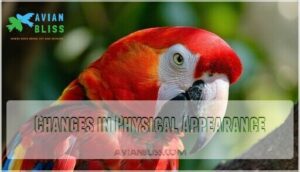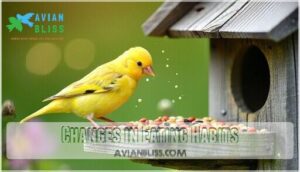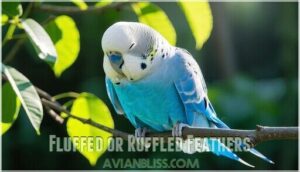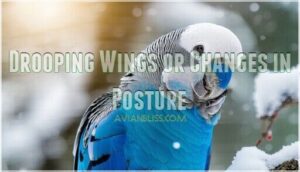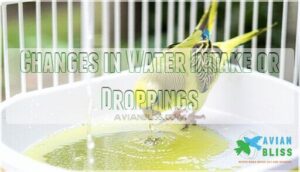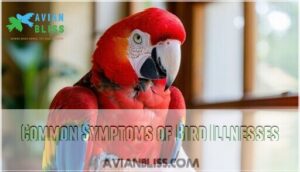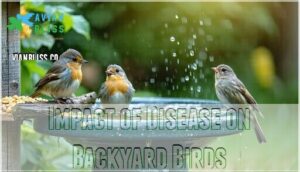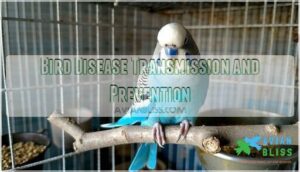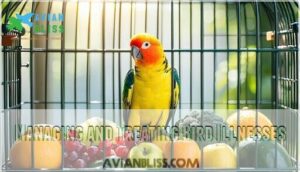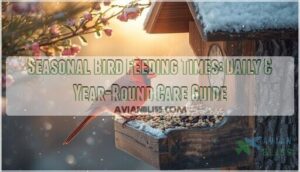This site is supported by our readers. We may earn a commission, at no cost to you, if you purchase through links.
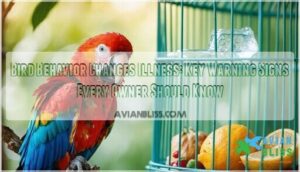
Aggression, biting, or obsessive feather picking? Those can signal stress or discomfort. If your bird’s perky vibe shifts to slouched or lethargic, it’s a major warning flag.
Even subtle signs, like picky eating or changes in droppings (normal ones should have white urates and clear urine), matter. Birds mask sickness well, so catching these behaviors early is key.
Keep your feathered friend thriving by staying observant—small signs can mean big issues. Curious about prevention tips? Stay tuned for more information on how to keep your bird healthy.
Table Of Contents
- Key Takeaways
- Recognizing Bird Behavior Changes
- Signs of Illness in Bird Behavior
- Physical Appearance Alterations
- Common Symptoms of Bird Illnesses
- Impact of Disease on Backyard Birds
- Bird Disease Transmission and Prevention
- Managing and Treating Bird Illnesses
- Maintaining a Healthy Backyard Bird Environment
- Monitoring and Responding to Bird Illnesses
- Frequently Asked Questions (FAQs)
- What are some common bird behavior problems?
- Why is my bird irritating?
- How do you know if a pet bird has health problems?
- What causes a bird to act out?
- What causes a bird to be discharged?
- How do environmental factors affect a bird’s behavior?
- How to tell if your bird has a respiratory infection?
- Do birds show signs of illness?
- What happens when one catches the bird flu?
- Do birds hide symptoms of illness?
- Conclusion
Key Takeaways
- Watch for subtle vocal changes – You’ll notice decreased chirping, hoarseness, or unusual silence as early warning signs that your bird isn’t feeling well, since healthy birds are typically vocal and active.
- Monitor eating and drinking habits closely – Changes in appetite, weight fluctuations, or shifts in water consumption often signal illness before physical symptoms appear, so don’t ignore picky eating or regurgitation.
- Pay attention to physical appearance shifts – Fluffed feathers that persist, drooping wings, unkempt plumage, or discharge from eyes and nostrils are red flags that require immediate veterinary attention.
- Act quickly on behavioral changes – Decreased activity, social withdrawal, increased aggression, or changes in posture indicate your bird’s trying to communicate distress, and early intervention can save their life.
Recognizing Bird Behavior Changes
You’ll notice a lot about your bird’s health just by paying attention to their behavior.
Sudden changes like decreased activity, unusual vocalizations, or unexpected aggression can be early signs something’s not right, and paying attention to these changes is crucial for the bird’s well-being.
Pay close attention to sudden bird behavior shifts—they’re often subtle cries for help that can save your feathered friend’s life.
Changes in Vocalization Patterns
Your bird’s voice is a window into its health, and any significant change can be a red flag.
Sudden hoarseness, reduced singing, or unusual noises might indicate bird vocalization illness. Silence signs or distress calls are often signals of respiratory issues or stress.
Here are three key signs of bird vocal changes:
- A normally chatty bird becoming unusually quiet.
- Vocalization patterns shifting to raspy or hoarse sounds.
- Sudden unusual vocalizations, like clicks or wheezing noises.
Pay attention—bird behavior changes illness starts with these small clues.
Decreased Activity and Lethargy
If your normally peppy parrot suddenly seems sluggish or uninterested, something’s up.
Lethargy isn’t laziness – it’s a common sign of discomfort or illness.
Recognizing discomfort early can help address potential causes of lethargy.
Watch for these signs:
- Spending most of the day perched quietly.
- Low energy during typical activity hours.
- Ignoring toys, food, or people they usually enjoy.
- Reluctance to fly or engage with surroundings.
- Moving slower or reacting less to sounds.
Prompt attention prevents inactivity from harming your bird’s health.
Changes in Appetite and Weight
Sometimes, what’s happening in the food bowl isn’t as it seems.
Reduced intake might be masked by leftover seed hulls, giving a false sense that your bird is eating enough.
Appetite changes like sudden loss of appetite, weight gain, or weight loss hint at bird behavior changes illness.
Increased thirst or food preferences shifting without warning can’t be ignored either.
If you spot regurgitation or sudden weight fluctuations, these are red flags.
Always consult your vet for proper attention and guidance.
Aggression or Irritability
A sweet bird turning snappy can be startling, but aggression often hides a deeper issue.
Sudden bird aggression is rarely random—it’s often a cry for help, signaling discomfort, stress, or possible illness.
Hormonal aggression, fear-based reactions, or pain-related irritability might explain sudden bird behavior changes.
Watch for cage territoriality or handling stress, like excessive screaming or biting.
These behavioral changes aren’t “just a phase” and often signal bird behavior abnormalities requiring a vet check to rule out illness or discomfort, which may be related to pain-related irritability.
Signs of Illness in Bird Behavior
When your bird’s behavior suddenly changes, it could be its way of saying something’s wrong.
Watch for shifts in activity, eating habits, or social interactions—these can be early clues to illness.
Changes in Physical Appearance
Your bird’s physical appearance speaks volumes about its health.
Keep an eye out for fluffed feathers that persist outside of rest, drooping wings, or odd postures, signaling discomfort.
Watch for nasal discharge, eye changes, or noticeable weight fluctuations.
Feather abnormalities like dull, broken, or missing feathers can indicate stress or illness.
Even subtle shifts in skin condition—like crusting or discoloration—mean it’s time to consult a vet.
Stay observant!
Changes in Droppings or Feathers
Keeping an eye on droppings and feathers is like reading your bird’s health journal. Changes in droppings, especially in color or texture, can signal trouble.
A bird dropping color chart becomes your handy translator here. Feathers, too, should be glossy and intact—watch for sudden feather loss or unusual molting patterns.
To stay ahead of bird behavior changes illness, check these five signs:
- Bright green or red droppings.
- Clumped or watery dropping consistency.
- Dull feather color or odd textures.
- Bald spots from feather loss.
- Prolonged or uneven molting.
Monitoring these signs helps in early detection of potential issues, allowing for timely intervention to prevent more serious health problems. By being vigilant about your bird’s droppings and feathers, you can take proactive steps to ensure its overall well-being.
Changes in Eating Habits
A bird’s eating habits speak volumes about its health.
Sudden loss of appetite, reduced intake, or an increased appetite is concerning.
Watch for weight changes or shifts in food preferences, like ignoring favorites.
If your bird picks through food or refuses water, it’s time to act.
Regurgitation that’s not a bonding behavior or unsuccessful feeding attempts usually signals illness.
Always monitor your bird’s diet and water consumption closely for abnormalities.
Changes in Social Interaction
When birds show behavioral changes like avoiding social interactions, it’s often a subtle cry for help.
Changes in bonding habits, such as a parrot refusing to step up or cuddle, might signal illness, stress, or discomfort. A once-chatty bird becoming quiet can also mean trouble. Reduced interaction with others—whether human or feathered friends—indicates something’s amiss.
- Isolation behavior like avoiding flock members or cage mates.
- Aggression increase toward companions or family.
- Withdrawal from playtime or familiar social interactions.
- Noticeable loss of interest in handling, toys, or daily routines.
Stay alert—early action could save lives!
Physical Appearance Alterations
If your bird’s feathers look fluffed, messy, or discolored, it could signal illness or stress.
Paying attention to changes like drooping wings or unusual discharge from their eyes or nose helps you catch problems early.
Fluffed or Ruffled Feathers
If your bird’s feathers stay fluffed like a permanent winter coat, it’s likely more than just heat conservation.
Persistent puffiness, especially alongside lethargy, points to illness detection. Preening difficulty or poor feather quality might signal an underlying illness.
Fluffed feathers could show your bird’s body is struggling, possibly fighting infection or pain. Assess severity by watching for other bird illness symptoms, and stay alert to sudden bird behavior changes indicating avian disease.
Drooping Wings or Changes in Posture
A healthy bird keeps its wings tucked neatly to its sides, but drooping wings can point to trouble.
Picture your bird looking like it’s wearing a slouchy coat—something’s off.
Here’s what to check:
- Are the wings uneven or dragging? This signals weakness signals or avian discomfort.
- Does posture seem strained? Respiratory distress might be to blame.
- Is your bird fatigued? Watch for signs of illness detection like subtle behavioral changes.
Unkempt Feathers or Changes in Plumage
Feathers tell a story – and messy, unkempt feathers are shouting “something’s wrong!”
Persistent fluffed feathers, dull plumage, or feather loss can signal stress, parasites, or poor nutrition.
Watch for abnormal molting or feather discoloration too.
Healthy birds preen regularly, so if your bird skips their grooming routine, it’s a red flag.
Feather abnormalities aren’t just cosmetic – they’re clues to your bird’s health.
Listen when they show you signs!
Discharge From Eyes or Nostrils
Pay attention to anything unusual around your bird’s eyes and nostrils. Discharge could mean trouble.
Here’s what to watch for:
- Clear, watery discharge might hint at mild irritation.
- Yellow or green discharge signals a possible infection.
- Crusty nostrils need urgent care—don’t wait!
- Swelling or redness, paired with breathing difficulty, screams avian respiratory infection.
Get them to a vetted professional quickly.
Decreased Appetite or Weight Loss
When appetite changes or weight fluctuations creep in, something’s amiss.
A bird skipping meals might face dietary deficiencies, crop impaction, or even malabsorption issues. Notice behavior shifts like appetite loss—it’s no time to wing it!
| Symptoms | Description |
|---|---|
| Appetite Loss | Ignoring treats or favorite seeds |
| Weight Fluctuations | Visible keel bone or plumper appearance |
| Behavior Adjustments | Lethargy or reduced enthusiasm for food |
Monitor closely for solutions!
Increased Appetite or Weight Gain
Don’t brush off noticeable weight fluctuations in your bird—it could be more than just extra snacks.
Hormonal imbalances, metabolic disorders, or dietary changes often cause behavioral changes, including overeating.
Limited exercise might play a role too.
Watch for appetite changes paired with quick weight gain; it can mask an underlying illness.
These subtle bird behavior changes aren’t harmless—get proactive and consult a vet if you notice these shifts.
Changes in Water Intake or Droppings
Notice something odd about droppings or water intake? Your bird might be sending a distress signal.
Watch for these signs:
- Dropping consistency changes—too loose or too firm.
- Unusual colors, like green or yellow.
- Increased or decreased water consumption.
- Strong-smelling bird droppings, a possible dietary impact.
- Signs of dehydration: dry cere or wrinkled skin.
Any of these can suggest kidney function troubles.
See a vet promptly!
Regurgitation or Vomiting
It’s unsettling to see your bird regurgitating or vomiting, but spotting these digestive symptoms early is key.
Regurgitation causes can range from stress to dietary factors, while vomiting differences often point to illness.
Monitor bird behavior changes closely, and don’t delay seeking treatment options.
Medication effects or vet advice can help resolve bird symptoms and guarantee a swift recovery.
Common Symptoms of Bird Illnesses
When your bird isn’t feeling well, it can show subtle changes in behavior or appearance that are easy to miss.
Recognizing common symptoms, like breathing difficulties or a loss of appetite, can help you act quickly and keep your feathered friend healthy, which involves understanding and identifying common symptoms.
Respiratory Symptoms
When you hear wheezing sounds or notice open-beak breathing, it’s time to pay close attention.
Respiratory symptoms like tail bobbing are cries for help.
Watch for labored breathing and nasal discharge—classic signs of an avian respiratory infection.
Here’s what to look for:
- Wheezing or crackling sounds
- Open-beak breathing
- Tail bobbing with each breath
- Thick nasal discharge
- Visible breathing difficulty
Digestive Symptoms
Keep an eye on your bird’s stomach health—it often tells the story of their well-being.
Look closely for these digestive symptoms:
- Regurgitation causes trouble, especially if food isn’t for sharing.
- Dropping changes, like odd colors or textures, are warning signs.
- Appetite alterations with weight loss signal malabsorption signs.
Birds hide symptoms well; don’t ignore these subtle bird behavior changes.
Consult an avian vet promptly!
Neurological Symptoms
Your bird tilting its head sideways might seem cute, but frequent head tilting could signal neurological symptoms.
Birds rely on head tilts to improve vision, but persistent tilts, along with circling behavior or loss of coordination, might point to deeper issues like infections or nerve damage.
Tremors or twitching muscles can also indicate seizures, which aren’t just “shaky moments” but serious health concerns.
If your bird stumbles, shows muscle weakness, or seems disoriented, don’t chalk it up to clumsiness: these bird behavior changes are major red flags.
Early action can make all the difference in addressing these bird illness symptoms, and it’s crucial to take them seriously to ensure the best outcome for your bird’s health, as they can be serious health concerns.
Skin and Feather Abnormalities
Feathers looking ruffled or showing unexpected changes can tell you a lot about your bird’s health.
Feather plucking isn’t just a bad habit—it often signals stress, boredom, or skin abnormalities, like mites or lice.
Notice any dull plumage or feather loss? That could mean poor nutrition, hormonal shifts, or even illnesses like Psittacine Beak and Feather Disease (PBFD).
Watch for skin lesions or abnormal growths, as they might hint at infections or irritations.
If your bird’s feathers seem unkempt or it’s avoiding preening altogether, that’s another red flag.
Healthy feathers shine, so any changes in feather condition deserve your attention.
A keen eye can make all the difference in spotting timely health issues.
Impact of Disease on Backyard Birds
When a bird gets sick, you’ll often notice subtle changes in its behavior, like staying still or acting irritable.
These shifts can impact both the bird’s health and the well-being of the entire backyard flock.
Physical Health Consequences
When illness takes hold, it’s like pulling the rug from under your bird’s health.
Organ damage, muscle atrophy, and bone weakening creep in silently, while immune suppression leaves them defenseless, and neurological decline impacts balance and coordination.
Look for telltale signs: fluffed feathers, drooping wings, or skin abnormalities.
Spotting these physical changes early can be lifesaving.
Behavioral Changes
Even the happiest birds can surprise you with a moody day, but certain behaviors may point to something bigger.
Watch for:
- Sudden Aggression: Unusual irritability or nipping tendencies.
- Social Isolation: Retreating from people or other birds.
- Vocalization Changes: Less chirping or odd sounds.
- Lethargy Signs: Sleeping more or avoiding toys and flying.
Notice patterns—they matter.
Population Health Effects
A sudden disease outbreak can ripple through backyard birds, causing species decline and shocking mortality rates.
With avian diseases spreading fast, bird behavior changes—like lethargy or isolation—often hint at bigger problems.
Early detection is essential to reduce ecosystem impacts and protect conservation efforts.
Stay vigilant and act promptly to curb illness before it devastates local populations and habitats, which is crucial for maintaining a healthy ecosystem.
Bird Disease Transmission and Prevention
Bird diseases can spread through direct contact, contaminated surfaces, or even pesky insects like mosquitoes.
You can protect your bird by keeping their environment clean, providing fresh food and water, and watching for any signs of illness.
This approach helps ensure the bird’s health and well-being by maintaining a clean environment.
Direct Contact Transmission
Close-knit bird interactions can spread illnesses faster than rumors at a bird party.
Watch out for these risky behaviors:
- Feather-to-Feather Contact spreads mites during preening practices.
- Saliva Exchange happens through shared food or water, aiding disease transmission.
- Parent-Chick Transmission can pass illnesses early in life.
- Mating Behavior increases exposure to infections through close physical contact.
Regular cleaning prevents the spread of disease, so consider using a bird feeder cleaner.
Keep an eye on these bird behavior changes to protect their health!
Indirect Contact Transmission
You mightn’t realize it, but bird disease transmission often happens through indirect contact with contaminated surfaces—this is called fomite transmission.
Dirty feeders, unwashed baths, and shared resources are perfect breeding grounds for bird illnesses.
Aerosol spread from sneezes or droppings also fuels environmental contamination, causing bird behavior anomalies like fatigue or appetite loss.
A tip? Stay ahead of bird behavior changes by scrubbing feeders and baths regularly.
Proper hygiene with a suitable feeder cleaner can help prevent the spread of disease.
Just think—your cleaning routine could save their tiny lives!
Vector-borne Transmission
Vector-borne transmission can sneak into your backyard through tiny, winged troublemakers. Mosquitoes can carry West Nile Virus or even spark Avian Malaria. Ticks? They’re infamous for spreading diseases.
Parasites like bird mites and feather lice can stress and weaken birds, affecting their health.
Here’s how vectors affect birds:
- Mosquito Transmission: Spreads viral diseases.
- Tick Vectors: Spread infections quickly.
- Mite Infestation: Causes stress.
- Feather Lice: Weakens birds.
Preventing Disease in Backyard Birds
Preventing avian diseases starts with feeder hygiene and water sanitation. Think of your feeder as a birdie bistro—clean “tables” keep the diners healthy.
Scrub feeders and change water regularly to stop germs from spreading. Proper habitat management, like clearing food spills, helps too.
Encourage natural immunity by planting native greenery and using quality seeds. Stay sharp with early detection—watch for odd bird behavior.
Regularly cleaning your feeders with a suitable cleaner product is also essential. Bird health monitoring is your secret weapon.
A clean, safe space means happy, chirping guests and effective bird illness prevention!
Managing and Treating Bird Illnesses
When your bird shows signs of illness, quick action can make all the difference.
Learning how to provide care, seek veterinary help, and guarantee a safe environment is key to their recovery.
Providing Supportive Care
Supportive care can make a big difference when your feathered friend feels under the weather.
Start with these five steps:
- Clean the cage daily for a stress-free environment.
- Provide warmth, like using a heating lamp.
- Maintain hydration support by replacing water regularly.
- Offer soothing dietary adjustments, like softer foods.
- Maintain a quiet environment to reduce stress and promote healing.
Contacting a Veterinarian
When your bird shows emergency signs, contacting an avian specialist is vital.
An experienced veterinarian can pinpoint health issues quickly. Be prepared with a kit for vet visits—it’s like having a safety net for sudden spills.
Don’t hesitate; early veterinary care often saves lives.
Afterward, follow the vet’s advice closely to guarantee lasting recovery and effective post-visit care, which is crucial for a lasting recovery.
Administering Medication
When it’s medication time, keep your bird’s stress low and your hands steady.
Use a syringe for precise dosage accuracy—birds can’t handle pills.
Gently restrain them without causing fear; calm, safe handling is key.
Follow your vet’s instructions closely and monitor effects on bird behavior.
Treating avian disease takes patience, but it’s essential for your bird’s health.
Quarantining The Bird
Keeping a sick bird separate isn’t fun, but it’s best for everyone’s health.
Creating a quarantine spot doesn’t need to be fancy—just safe and comfortable.
Set up a cozy isolation space with:
- Separate cage: Keeps illness contained while reducing stress.
- Hygiene protocols: Regular cleaning to prevent further infection.
- Monitoring progress: Check droppings, appetite, and bird behavior daily.
- Easy vet access: Be ready to call if symptoms worsen.
When reintroducing the bird, confirm they’re healthy.
This process respects their healing time and guarantees long-term well-being for your feathered friends.
Maintaining a Healthy Backyard Bird Environment
You’ve got a big role in keeping birds healthy by maintaining a safe and clean backyard environment.
Simple actions like cleaning feeders, providing fresh water, and planting native plants can make a huge difference.
Cleaning Feeders and Waterers
Giving feeders and waterers a daily scrub isn’t just about cleanliness—it’s about keeping bird health in check.
Use birdsafe cleaners and rinse well to prevent bird illness. Avoid mold by drying completely before refilling. Stick to this cleaning frequency to keep bacteria at bay.
| Task | Frequency | Purpose |
|---|---|---|
| Scrubbing Feeders | Daily | Bird safety |
| Emptying Old Water | Twice a day | Preventing mold |
| Thorough Rinse | Each Cleaning | Safe solutions |
| Allowing to Fully Dry | After Each Use | Avoid bacteria growth |
Providing Fresh Food and Water
Don’t underestimate the impact of offering birds clean, fresh food and water—it’s like rolling out the red carpet for their health.
Keep water sources clean and safe for hydration. Prevent food spoilage with proper storage and daily checks.
Include a variety of seeds, fruits, and grains to meet nutritional needs.
- Tips for success:
- Replace water daily to prevent contamination.
- Store bird food in sealed containers.
- Monitor food for mold or debris.
Managing Spills and Debris
Overflowing feeders mean more than a mess—they’re a highway to bird health problems.
Use spill containment tools and stay on top of debris removal. Toss waste safely to curb pests and lower disease risks.
A little effort with cleaning solutions boosts bird health. Smart preventative measures like managing spills can prevent bird behavior changes tied to illness.
Clean spots, healthy birds!
Planting Native Vegetation
Native plants are tailor-made for birds, offering food, shelter, and a home sweet home.
Boost your yard’s charm by:
- Choosing Local Favorites: Native flowers, shrubs, and trees enhance ecosystems and attract more birds.
- Creating Safe Zones: Add bird-friendly plants for nesting and cover.
- Offering Natural Snacks: Add berries and nectar sources.
- Supporting All Seasons: Guarantee year-round blooms sustain bird health.
Monitoring and Responding to Bird Illnesses
You’ve got to watch your birds closely—small changes in their behavior can signal big health problems.
Acting quickly when you spot unusual signs can make all the difference in keeping them safe and healthy.
Monitoring Bird Behavior and Health
Spot changes early with routine observation.
Track bird behavior using a log, noting patterns like singing (cheerful, frequent), eating (steady), and preening (thorough).
Environmental enrichment helps maintain engagement.
Watch for shifts in energy or socializing habits—early detection of oddities can signal distress.
Proactive healthcare and stress reduction keep animal health in check.
Stay vigilant—it’s wildlife monitoring in action!
Reporting Sick Birds to Authorities
If your bird seems sick, reporting it could save a flock!
Wildlife agencies rely on public reports to monitor avian disease outbreaks.
Follow these steps for a quick response:
- Contact local wildlife authorities for reporting protocols.
- Note behavior changes like lethargy or odd droppings.
- Don’t touch infected birds without gloves.
- Help track outbreaks for early detection and public health safety!
Taking Immediate Action
When your bird looks under the weather, act fast—it could save their life!
- Isolate the sick bird immediately to reduce infection risks.
- Consult an avian vet for expert advice and care.
- Provide emergency first aid, like warmth and hydration.
- Monitor symptoms closely, especially droppings and behavior.
Quick action and preventative measures guarantee better outcomes for your feathery friend!
Collaborating With Wildlife Rehabilitators
Collaborating with wildlife rehabilitators can feel like adding an expert to your team when dealing with bird illness or behavior changes.
These rehab partnerships help with bird rescue, orphan care, and even release protocols for recovering birds. They’re pros at analyzing bird behavior, spotting illness, and minding legal aspects too.
Want to volunteer or learn more? Contact shelters or join webinars.
Need to report a sick bird? Use online forms. Stay informed by signing up for newsletters—they’re like getting inside tips straight from the experts in animal behavior!
Frequently Asked Questions (FAQs)
What are some common bird behavior problems?
Imagine your parrot suddenly starts biting everyone—it’s frustrating, right?
Common bird behavior problems include biting, excessive screaming, feather plucking, over-bonding, and aggression.
These often stem from stress, boredom, hormonal changes, or territorial instincts.
Why is my bird irritating?
Your bird’s irritation likely stems from hormonal changes, territorial behavior, stress, or underlying health issues.
Check for environmental changes, breeding season triggers, or physical discomfort that might be causing this behavioral shift.
How do you know if a pet bird has health problems?
Watch for fluffed feathers, drooping wings, changes in droppings, decreased activity, altered vocalizations, and eating habits. Your bird’s behavior shifts often signal illness before physical symptoms appear—trust your instincts.
What causes a bird to act out?
Stress, illness, hormonal changes, or environmental disruptions trigger acting out in birds.
You’ll notice aggression, feather plucking, excessive screaming, or territorial behavior when they’re uncomfortable, scared, or trying to communicate their needs, which can include feather plucking.
What causes a bird to be discharged?
Like a leaky faucet signals plumbing trouble, discharge from your bird’s eyes or nostrils indicates infection or respiratory issues.
You’ll notice yellow, green, or clear fluid requiring immediate veterinary attention for proper diagnosis.
How do environmental factors affect a bird’s behavior?
Environmental changes like temperature shifts, lighting variations, noise levels, and cage placement directly impact your bird’s mood and activity.
Poor air quality, drafts, or sudden habitat modifications can trigger stress responses and behavioral shifts.
How to tell if your bird has a respiratory infection?
Your bird’s breathing tells the story – watch for open-mouth breathing, tail bobbing with each breath, wheezing sounds, or nasal discharge.
These respiratory red flags mean it’s time for an immediate vet visit.
Do birds show signs of illness?
Yes, birds definitely show illness signs, but they’re masters at hiding them. You’ll notice subtle changes in behavior, eating habits, feather condition, and energy levels before obvious symptoms appear.
What happens when one catches the bird flu?
When this viral invader strikes, you’ll face fever, chills, and respiratory distress that feels like drowning on dry land.
Severe cases cause pneumonia, organ failure, and death, making immediate medical attention absolutely critical for survival.
Do birds hide symptoms of illness?
Unfortunately, your feathered friends are masters of disguise when they’re sick. They’ll mask symptoms until they’re critically ill, making early detection challenging but essential for their survival.
Conclusion
Knowledge is your feathered friend’s lifeline in terms of spotting trouble early.
Recognizing bird behavior changes illness brings can mean the difference between a quick recovery and serious health complications.
You’ve learned to watch for vocal shifts, appetite changes, and physical symptoms that signal distress.
Don’t ignore subtle warning signs—your bird depends on your vigilance.
Stay observant, act quickly when something seems off, and maintain regular vet checkups to keep your companion healthy and thriving.
- https://www.thesprucepets.com/common-diseases-in-pet-birds-390443
- https://nestboxlive.com/blog/bird-flu-virus-the-impact-on-our-backyard-birds/?srsltid=AfmBOopXlzPR5ewa-nCilypG_POpyWdKikpTgqxhjJSHpMh0glSAowXR
- https://marin.wbu.com/backyard-bird-disease
- https://www.merckvetmanual.com/exotic-and-laboratory-animals/backyard-poultry/common-infectious-diseases-in-backyard-poultry
- https://ebird.org/region/US-MT-025/post/common-diseases-in-backyard-birds

